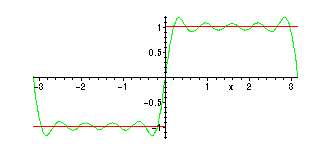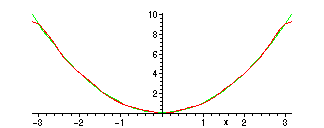MATH 373 -- Applied Mathematics (PDE)
February 20, 2001 -- First examples of Fourier Series
A) Consider the function
f(x) = -
1 if
![]() <=
x <
0, and 1 if 0 <=
x <=
<=
x <
0, and 1 if 0 <=
x <=
![]()
The Fourier coefficients are given by
> assume(n,integer);
> f := x->piecewise(x<0,-1,1):
> af := n->int(f(x)*cos(n*x),x=-Pi..Pi)/Pi;
![[Maple Math]](images/Fourier3.gif)
Since
f
is an odd function,
![]() for all
n >=
0:
for all
n >=
0:
> af(n);
![]()
> bf := n->int(f(x)*sin(n*x),x=-Pi..Pi)/Pi;
![[Maple Math]](images/Fourier6.gif)
> bf(n);
![[Maple Math]](images/Fourier7.gif)
To visualize the Fourier series, we can plot partial sums:
> PSf:=(N,x)->add(bf(n)*sin(n*x),n=1..N);
Warning, `n` in call to `add` is not local
![]()
> plot({f(x),PSf(10,x)},x=-Pi..Pi);

B) Now, consider
g(x) =
![]() on
on
![]()
> g:=x -> x^2;
![]()
> ag := n->int(g(x)*cos(n*x),x=-Pi..Pi)/Pi;
![[Maple Math]](images/Fourier13.gif)
> ag(0);
![]()
> ag(n);
![[Maple Math]](images/Fourier15.gif)
> bg := n->int(g(x)*sin(n*x),x=-Pi..Pi)/Pi;
![[Maple Math]](images/Fourier16.gif)
Now, the
![]() coefficients are zero, because
g
is even.
coefficients are zero, because
g
is even.
> bg(n);
![]()
To visualize the Fourier series, we can plot partial sums:
> PSg:=(N,x)->ag(0)/2+add(ag(n)*cos(n*x),n=1..N);
Warning, `n` in call to `add` is not local
![]()
> plot({g(x),PSg(5,x)},x=-Pi..Pi);

Note that the approximation to the function g given by the partial sum of the
Fourier series seems much closer in this case than in example A.